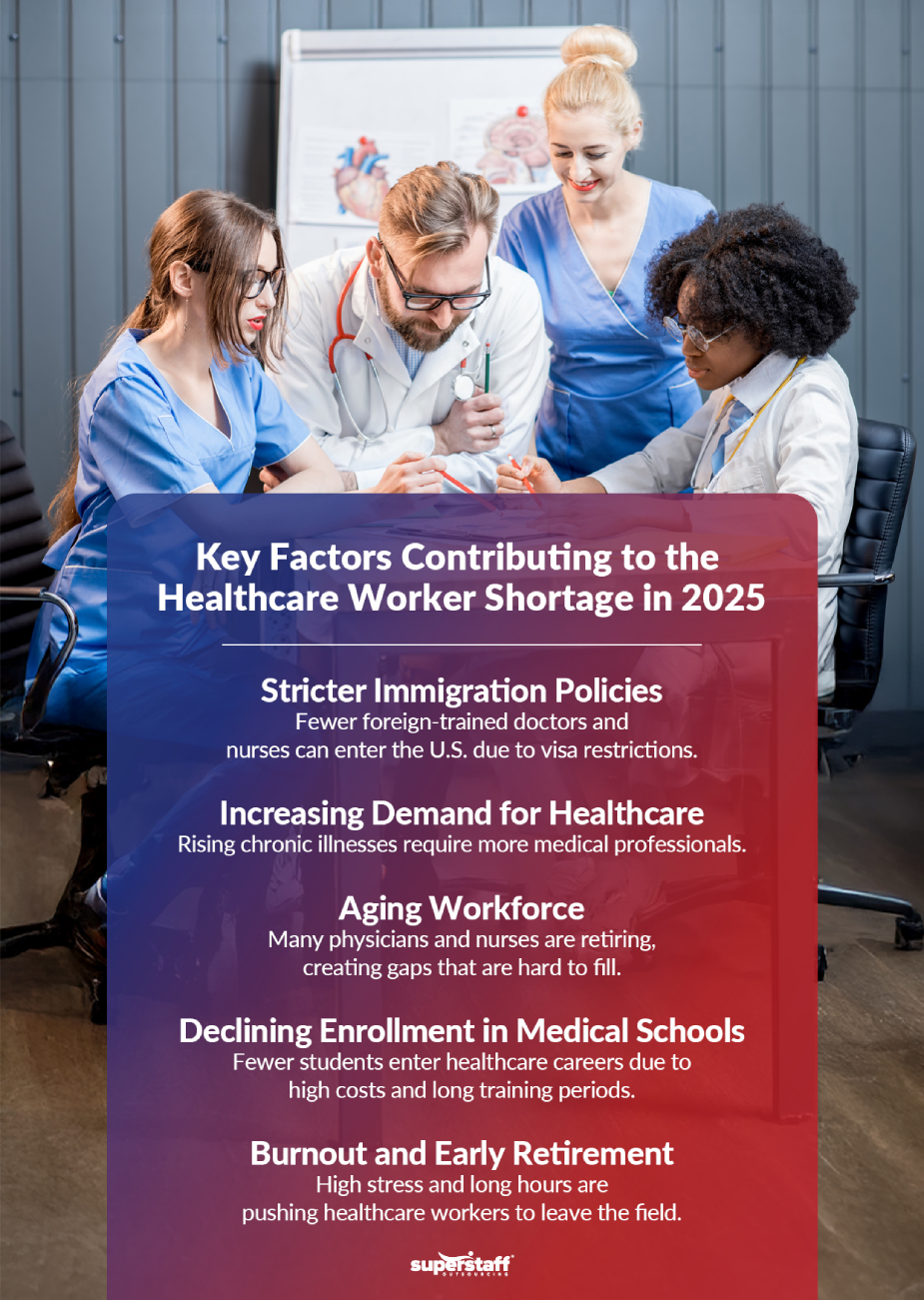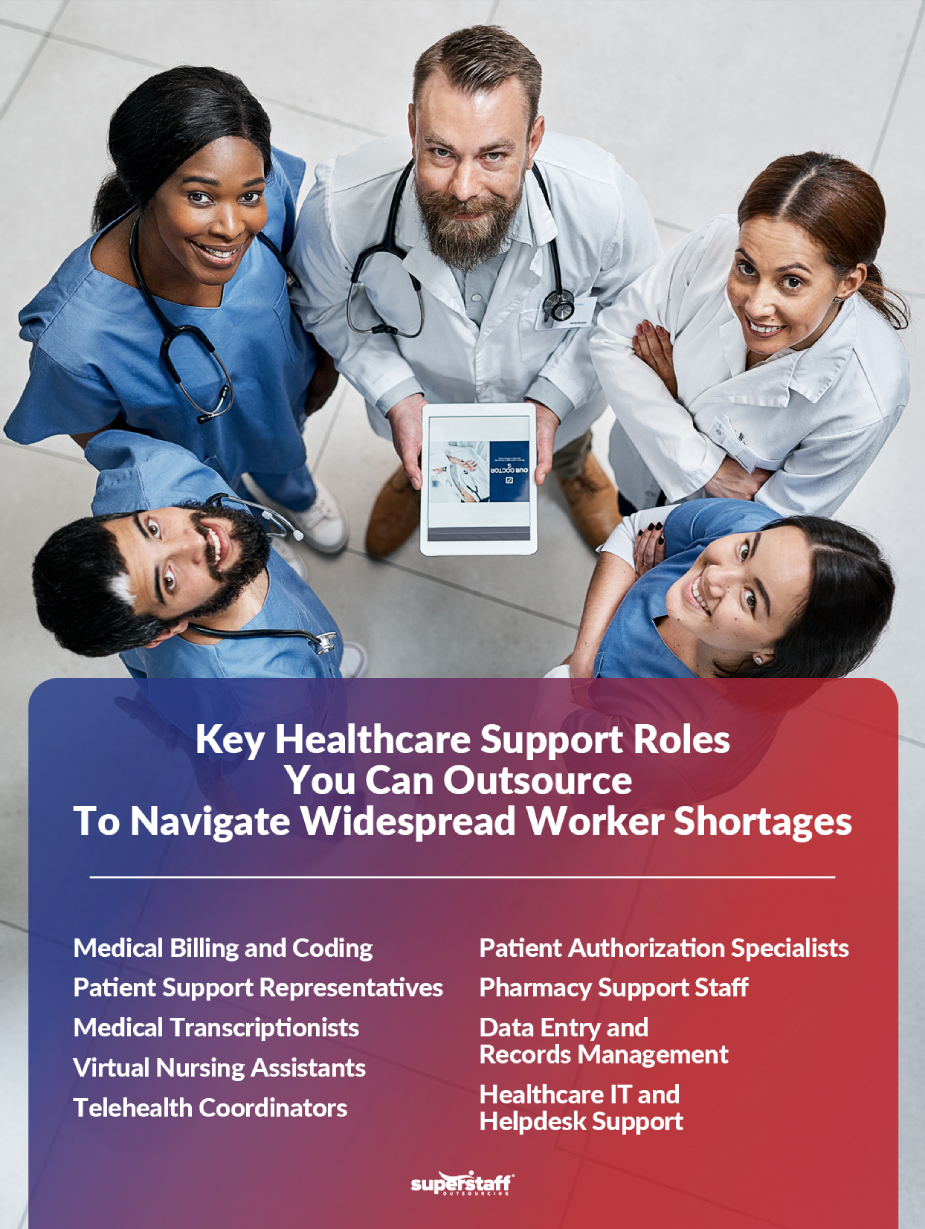
The healthcare worker shortage in the U.S. is reaching a critical point. With an aging population driving higher demand for medical services, the industry was already struggling to fill essential roles. Now, stricter immigration policies are worsening the crisis, making it even harder for hospitals and clinics to hire much-needed healthcare professionals.
Foreign-trained doctors, nurses, and medical support staff have long been crucial in addressing workforce shortages. However, tightened visa restrictions and immigration hurdles disrupt the talent pipeline, leaving healthcare facilities scrambling to maintain service levels. As labor gaps widen, patient care quality and operational efficiency are at serious risk.
This blog explores how stricter immigration regulations exacerbate the healthcare worker shortage and how outsourcing presents a viable solution. By leveraging global talent, healthcare providers can ensure continuity of care, improve efficiency, and mitigate staffing risks. In today’s challenging labor market, organizations must rethink their workforce strategies to maintain high-quality patient care.
Why Is There a Healthcare Worker Shortage?: Understanding the Current Medical Landscape
The U.S. healthcare sector is already in a severe labor shortage, with demand for medical professionals far exceeding supply. According to the Association of American Medical Colleges (AAMC), the country could face a shortfall of up to 86,000 physicians by 2036, putting immense strain on hospitals, clinics, and healthcare systems.
The crisis extends beyond physicians—nurses are also leaving the profession at alarming rates due to burnout, stress, and early retirement. The COVID-19 pandemic accelerated these trends, pushing many healthcare workers to exit the field earlier than expected.
As a result, patient care is at risk, wait times are increasing, and healthcare facilities are struggling to maintain adequate staffing levels. Without immediate and sustainable workforce solutions, the shortage will continue to worsen, jeopardizing the quality and accessibility of medical services nationwide. Some of the reasons for the healthcare worker shortage include:

Increasing Demand for Healthcare Services
The U.S. population is aging rapidly, driving a surge in demand for medical services. As baby boomers enter retirement age, chronic conditions such as heart disease, diabetes, and arthritis are becoming more prevalent, requiring ongoing medical care.
Additionally, advancements in medical technology and treatments have extended life expectancy, further increasing the need for healthcare professionals. However, the workforce is not expanding at the same rate, leading to severe staffing shortages across hospitals, clinics, and long-term care facilities.
Declining Enrollment in Medical and Nursing Schools
While demand for healthcare workers is rising, fewer students are pursuing careers in medicine and nursing. Enrollment in medical and nursing programs has not kept pace with industry needs, partly due to high tuition costs, long years of training, and concerns over workplace stress.
Many prospective students are deterred by the financial burden of medical education, which can lead to six-figure debt before entering the workforce. For nursing, the problem is compounded by faculty shortages, limited clinical training slots, and high attrition rates among students. As a result, fewer professionals are entering the field, worsening the already critical shortage.
Aging Workforce Leading to Retirements
Much of the current healthcare workforce is nearing retirement, creating a substantial gap in available personnel. According to the National Council of State Boards of Nursing (NCSBN), nearly one-fifth of registered nurses plan to retire in the next five years. Similarly, many physicians, particularly in primary care and specialized fields, are reaching retirement age, leaving positions unfilled.
The loss of experienced professionals also impacts mentorship and training for new healthcare workers, slowing the pipeline of qualified talent. Without an influx of younger professionals, the U.S. healthcare system will struggle to meet patient needs. Finally, another crucial factor influencing the current medical worker shortages is U.S. President Donald Trump’s immigration policy.
The Role of Immigration in Healthcare Staffing
For decades, foreign-born healthcare professionals have been essential to the U.S. healthcare system, helping to fill critical workforce gaps. Currently, around 17% of all healthcare workers in the U.S. are immigrants, including physicians, nurses, and support staff. Many of these professionals serve in areas where domestic talent is scarce, ensuring patients receive the care they need, regardless of location.
Addressing Shortages in Underserved Areas
Foreign-trained doctors and nurses are especially vital in rural and underserved communities, where healthcare access is already limited. Many U.S.-trained professionals prefer to work in metropolitan areas, leaving smaller towns and remote regions struggling with severe staffing shortages. International medical graduates (IMGs)—doctors who earned their medical degrees outside the U.S.—play a key role in bridging the physician shortage by practicing in these high-need areas.
The Impact of Visa Restrictions on Healthcare Staffing
Despite their contributions, foreign healthcare workers face growing challenges due to stricter immigration policies. The U.S. relies on various visa programs, such as the H-1B visa for highly skilled workers and the J-1 visa for medical residency programs, to bring in foreign-trained professionals. However, recent policy changes have made it more difficult for hospitals and clinics to sponsor visas, limiting access to this essential workforce. As a result, facilities that once depended on foreign talent are now experiencing longer hiring timelines, higher recruitment costs, and critical staffing shortages.
Stricter Immigration Laws Are Worsening the Crisis
Tight immigration laws further strain the already shrinking domestic healthcare workforce. Many foreign healthcare professionals willing and qualified to work in the U.S. cannot secure work visas, exacerbating the nationwide healthcare worker shortage. Without policy adjustments to support the entry of international medical talent, hospitals, long-term care facilities, and rural clinics will continue to struggle, putting patient care and healthcare accessibility at risk.
As the demand for healthcare services rises, immigration remains a key factor in maintaining a stable, well-staffed medical workforce. Policymakers, healthcare leaders, and industry stakeholders must explore solutions that balance national labor needs with immigration policies to ensure high-quality, accessible healthcare for all.
Stricter Immigration Policies and Their Impact on the Medical Industry
Recent immigration policy changes have made it increasingly difficult for foreign healthcare professionals to work in the U.S., exacerbating the ongoing healthcare worker shortage. Under Trump’s immigration policy, restrictions on H-1B and J-1 visas—both critical pathways for foreign medical professionals—have tightened, leading to longer processing times, stricter eligibility requirements, and a reduced pool of qualified candidates. These changes have created significant hurdles for hospitals and healthcare facilities that rely on internationally trained talent to fill workforce gaps.
H-1B and J-1 Visa Restrictions Slowing Recruitment
The H-1B visa, typically used to bring highly skilled healthcare professionals such as doctors and medical researchers into the U.S., has become increasingly difficult to obtain due to caps, higher wage requirements, and extensive documentation demands. Meanwhile, J-1 visa restrictions have made it harder for international medical graduates (IMGs) to complete residencies in the U.S., limiting the number of foreign-trained doctors entering the workforce. These stricter policies have delayed hiring cycles, administrative roadblocks, and uncertainty for employers and workers.
Hospitals Struggling to Fill Critical Positions
With fewer foreign healthcare professionals entering the U.S., hospitals and healthcare providers face prolonged hiring processes and a shrinking talent pool. Facilities that once depended on internationally trained nurses and allied health professionals are now struggling to recruit replacements, leading to increased strain on existing staff. Nurses and physicians are overworked, burnout rates are rising, and patient care quality is at risk.
The Ripple Effect on Patient Care
As foreign-trained medical professionals become less accessible, the burden falls on a stretched domestic workforce. Longer shifts, increased patient loads, and higher turnover rates are becoming common, worsening the staffing crisis. Without an adequate talent pipeline, hospitals may be forced to reduce services, increase wait times, or compromise care quality, particularly in rural and underserved areas that rely heavily on international medical professionals.
Stricter immigration policies have a direct impact on healthcare staffing, limiting access to skilled professionals at a time when demand is at an all-time high. To prevent further workforce shortages, the U.S. must consider revising immigration policies to accommodate the growing need for medical talent and ensure that healthcare providers can continue delivering high-quality care.
Outsourcing in Healthcare Services: A Strategic Solution for Navigating Industry-Wide Shortages
As the healthcare worker shortage intensifies, outsourcing has emerged as a viable solution to mitigate workforce gaps. By leveraging global talent, U.S. healthcare providers can access skilled professionals remotely, ensuring uninterrupted patient care and operational efficiency. Healthcare outsourcing has expanded significantly recently, with offshore teams supporting everything from administrative tasks to telehealth services and medical billing.
What Is a Healthcare Outsourcing Company?
With the increasing demand for healthcare services and ongoing staffing shortages, many hospitals, clinics, and healthcare organizations are turning to offshore teams to supplement their workforce. Countries like the Philippines and Colombia have developed robust specialty healthcare outsourcing industries, offering highly trained nursing support, medical administration, and healthcare IT professionals. This shift has allowed U.S. healthcare providers to scale their workforce efficiently while maintaining high service quality.
Remote Healthcare Professionals and Offshore Support
Outsourcing extends beyond traditional administrative roles—remote healthcare professionals can provide essential patient support services. Virtual nurses, telehealth assistants, and remote patient coordinators help manage patient inquiries, monitor chronic conditions, and support follow-up care. These offshore healthcare professionals enhance accessibility, especially in rural and underserved areas where medical staff shortages are most severe.
Benefits of Outsourcing Administrative Healthcare Tasks

One of the most effective ways to ease the burden on overworked U.S. healthcare staff is by outsourcing time-consuming administrative tasks. Offshore teams can handle the following:
- Medical coding and billing, ensuring accurate insurance claims and reimbursement.
- Patient scheduling and records management, freeing up in-house staff to focus on direct patient care.
- Prior authorization and insurance verification, reducing wait times for medical procedures.
By delegating these tasks to highly trained offshore teams, healthcare facilities can improve efficiency, reduce costs, and allow their in-house staff to focus on patient care rather than paperwork.
The Rise of Virtual Nursing and Telehealth Support
With the rapid expansion of telehealth, virtual nursing support has become an essential service. Offshore nurses and telehealth assistants can assist with the following:
- Remote patient monitoring, tracking vital signs, and managing chronic conditions.
- Triage services, assessing patient symptoms and directing them to the appropriate care level.
- Post-discharge follow-ups, ensuring patients adhere to treatment plans and medications.
By integrating virtual nursing and telehealth solutions, healthcare providers can extend their reach and provide 24/7 patient support without overwhelming their in-house teams.
Offshore Medical Coding and Billing Teams
Medical coding and billing are critical yet labor-intensive tasks that require accuracy and compliance with complex U.S. healthcare regulations. Outsourcing these functions to offshore teams ensures that claims are processed efficiently and correctly, reducing claim denials and improving revenue cycle management. Experienced offshore professionals can navigate ICD-10, CPT, and HCPCS coding systems, helping healthcare providers streamline operations and reduce administrative burdens.
A Scalable Solution for the Future
As workforce shortages continue, outsourcing provides a scalable, cost-effective, and high-quality alternative to bridge the gaps in healthcare staffing. By leveraging offshore teams for clinical support and administrative functions, healthcare organizations can maintain high patient care standards while easing the strain on their in-house workforce. As the industry evolves, healthcare outsourcing will play an increasingly vital role in sustaining service delivery and addressing workforce challenges.
How Healthcare Providers Can Get Started with Outsourcing
Implementing outsourcing in the healthcare industry requires careful planning and the right partnerships to ensure seamless integration and compliance with industry regulations. Healthcare providers should follow these key steps:
- Identify Outsourcing Needs – Determine which functions (e.g., medical coding, patient coordination, telehealth support) can be efficiently outsourced.
- Choose the Right Outsourcing Partner – Evaluate providers based on compliance with HIPAA and healthcare regulations, industry experience, and scalability.
- Develop a Transition Plan – Establish transparent workflows, communication channels, and training programs to integrate outsourced teams smoothly.
- Ensure Compliance and Data Security – Work with outsourcing partners that follow strict data protection policies and industry best practices.
- Monitor Performance and Optimize – Regularly assess efficiency, quality, and patient satisfaction to refine outsourcing strategies for long-term success.
By selecting a trusted outsourcing partner, healthcare providers can reduce costs, improve operational efficiency, and maintain high-quality patient care without disruption.
Future-Proof Your Medical Workforce: Why Outsourcing in the Healthcare Industry Is the Answer
The healthcare worker shortage is not just a temporary challenge—it’s a long-term crisis worsened by immigration restrictions and a shrinking domestic workforce. With stricter visa policies limiting access to foreign-trained professionals, healthcare providers must explore alternative solutions to ensure uninterrupted, high-quality patient care.
Outsourcing presents a cost-effective and scalable way to fill critical gaps. It allows medical institutions to leverage global healthcare talent, from virtual nursing support to medical coding and patient coordination. As the industry evolves, future healthcare models will increasingly rely on global workforce integration to maintain efficiency and service excellence.
Now is the time for healthcare providers to rethink their staffing strategies and embrace outsourcing as a sustainable solution. As a leading back-office service provider in the Philippines, SuperStaff offers specialized healthcare outsourcing services designed to help organizations reduce costs, improve efficiency, and maintain top-tier patient care.
Contact SuperStaff today to explore tailored outsourcing solutions that keep your healthcare operations running seamlessly.





